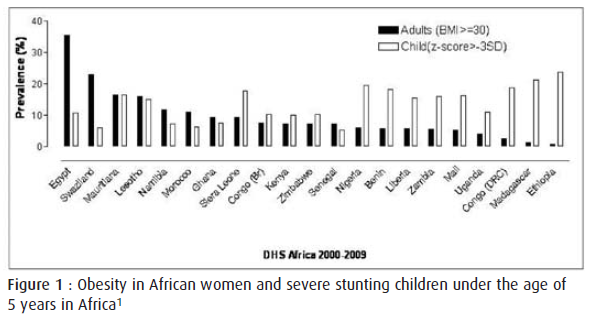WHAT ABOUT VEGETABLES AND FRUIT? »
Food Insecurity may explain the age difference in body size in Africa
When contemplating nutritional disorders on the African continent, until recently, under-nutrition has been at the forefront of considerations. Over the last decade we have been seeing evidence that suggest over-nutrition to have already been entrenched in Africa, to the extent where the prevalence of obesity in adults often surpasses that of underweight in children under the age of five years1.
The nutritional status of Africans
The Demographic and Health Surveys (DHS) of Africa suggest overnutrition in women to co-exists, with under-nutrition in children in many African countries1. Figure 1 presents data suggesting obesity in adult women to rival that of severe stunting in children.

Causes of under-nutrition in Africa
Food insecurity (FI) is associated with under-nutrition given its definition that it is a lack of access to nutritionally balanced and diverse diets2. The consistent emerging trend in Africa indicates that in households affected by FI, women are reducing the quality of the food their family eats, or are feeding their children poor quality foods, or they skip their meals so that their children can eat3-5. African households that are food insecure spent less money on food than their food secure counterparts1-3. The National Food Consumption Survey (NFCS) of South Africa3 highlighted that the number of food items in the South African home inventory was influenced by the household’s income, such that an average of less than eight different food items was observed in poorer households compared to 16 from their higher income counterparts. The secondary analysis of the NFCS of South Africa also indicated that the dietary diversity and variety scores of children (1-9 years) in poor households were dismal, with more than a third of these children recording low diversity and variety in their diet. Labadarios et al.’s findings in 2010, further established that the majority of South Africans consume a diet that is low in dietary variety6,7. Poorer and rural households were the worst affected, with animal products and vitamin A rich fruits and vegetables being the least consumed.
Causes of over-nutrition in Africa
Associating FI with over-nutrition may seem erroneous given its aforementioned definition. However, there is strong evidence supporting the concept that FI does not only associate with under-nutrition in children but also with over-nutrition in women3-8. Certainly, the association between FI and obesity among women is by no means causal, indeed it may be a function of emerging affluence, and requires further investigation. However, it should be borne in mind that within food insecure African households, it is common to find women who naturally select energy-dense foods during times of food shortage as a mechanism of survival8. Energy-dense foods typically contain high quantities of fat, sugar and/or starch, as opposed to low-energy dense foods which are higher in fibre and micronutrients, such as fruit and vegetables8,9. Further, energy-dense foods cost less per unit of Energy than animal products, fruits and vegetables9. As such, women lacking adequate resources may be purchasing these less expensive energydense foods in order to alleviate hunger3,9,10. Indeed, The NFCS documented that in food insecure South African households the most commonly procured food items were maize (94%), sugar (93%) and bread (52%) and hard margarine or cooking fat (59%)3. Availability of these energy-dense food items in the households seems to translate into them being commonly consumed. Similarly, Steyn et al. observed results that suggest poor Kenyan women to consume less fruits, vegetables and animal protein, but higher energy-dense foods such as maize (68%), sugar (88%), bread (46%), fats and oils (73%)10. In both the afore-mentioned studies women in these poor households presented with a higher BMIs3,10.
Summary and conclusions
In Africa, both under-nutrition and obesity may well be “by-products” of FI within poorer households. The results show a cause for concern in view of the challenging goal to achieve food security in totality. The FAO suggests achieving food security in totality by improving food availability; food access; food utilization; as well as food stability in each household at all times2. In this regard, it may therefore be necessary to conduct an audit of the already abundant African food policies to evaluate their content, recommendations and the extent to which they are effectively implemented to increase dietary variety and reduce FI. It would appear that these policies might be promoting overconsumption of certain foods more than others, given the current evidence presented in this review, which indicates that the basis of African diets appear to be carbohydrates and fats, with a lower than recommended intake of protein (from animals), vegetable and fruits.
References
- Measure Demographic and Health Surveys (DHS) on line: STATcompiler. Building tables with DHS data. Accessed [15 July 2010] Available at http://www.cdc.gov/reproductivehealth/Surveys
- FAO. The state of Food Insecurity in the World: Monitoring progress towards the World Food Summit and Millennium Development. Food and Agriculture Organization of the United Nations 2004.
- Labadarios D (ed.). The National Food Consumption Survey (NFCS): Children aged 1–9 years, SA, 1999. Pretoria: Directorate: Nutrition, Department of Health, National Food Consumption Survey Consortium, Stellenbosch, South Africa 2000.
- Labadarios D et al. SA Journal of Clinical Nutrition 2008; 21(3) (Suppl. 2):247–300.
- South African Social Attitudes Survey (SASAS). Human Science Research Council 2008. Available at www.hsrc.ac.za
- Steyn NP et al. Public Health Nutrition. 2006; 58:912-13.
- Labadarios D et al. Nutrition Journal. 2011;10:33.
- Tarasuk V et al. Low-income women’s dietary intakes are sensitive to the depletion of houshold resources in one month. J Nutr. 2007; 137:1980-87.
- Temple NJ, Steyn NP. Food prices and energy density as barriers to healthy food patterns in Cape Town, South Africa. Journal of Hunger and Environmental Nutrition 2009; 4:203-213.
- Steyn NP et al. Dietary, social and environmental determinants of obesity in Kenyan women. Scandinavian Journal of Public Health. 2011; 39:88-97.
